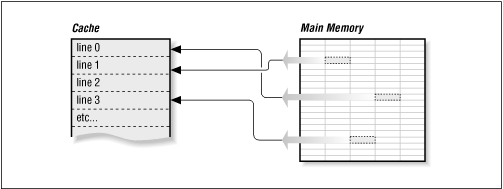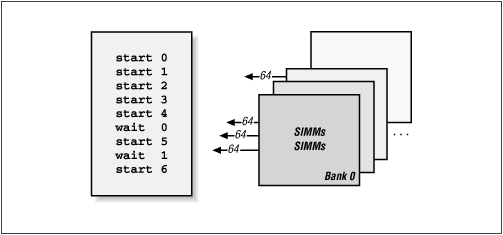- petabytes (PB) of storage (petabyte is 1015 bytes) for files and such,
- gigabytes (GB) of memory (gigabyte is 109 bytes) for running
programs.
Note: Interpreter + user program + data *or* Compiler processes user program to produce object code which must all fit in memory; then object code + data runs in memory. More details in a couple of weeks when we cover Ch. 5 What a Compiler Does - teraflops (TFLOPS) - overall measure of processor speed (teraflop is 1012 flops, or Floating Point Operations per Second). More details \ next week when we cover Ch. 4 Floating Point Numbers
- input-output (I/O) capacity of hundreds gigabits (Gb) per second.
(NOTE: Gb and GB differ by nearly an order of magnitude (factor of 10)
(p. 33 Text) Example Memory Technology Access Time: 1981 IBM XT 8088 access time of commodity DRAM (200ns) was shorter than the clock cycle time (4.77 MHz)
4.77 MHz ? < ? 210ns
What does that really mean? Let's convert 200 ns (nanoseconds) to MegaHertz since they are reciprocals:
1/200 ns ~= 1/(200*10-9) = 1/2 * 1/10-7 = 0.5*10+7 = 5.0 E+6 this gives a clock cycle time that would allow roughly 5 Million Cycles per Second, i.e. 5MHz.
What memory response is needed to keep up with 1.8 Ghz Pentium4?
Let's work on the board. 1.8 GHz ~= 2 GHz ~= 1/?
What memory response is needed to keep up with 330 MHz Pentium?
1/[330*106] = 1/.33*109 =~ 1 / [1/3 * 109] = 3 ns memory chip -->
Economics is a driving force in computing. Possible approaches to memory performance
- Every memory system component made individually fast enough to keep up with each memory access request
- Slow memory used in round-robin fashion to give the effect of faster memory systems
- Memory system design made wide to each transfer contains main bytes of memory
- System divided into faster and slower portions and arranged so fast portion used more often than slow.
In this chapter we will focus on
- Memory Technology (different access times)
- DRAM (dynamic random access memory)
- SRAM (static random access memory).
- Access time
- Registers
- Caches (but not the Cache Organization topics)

Fig. 3-1: Cache lines can come from different parts of memory
© O'Reilly Publishers (Used with permission)
Interleaved and Pipelined Memory Systems
Fig. 3-9 Multibanked memory system

© O'Reilly Publishers (Used with permission)